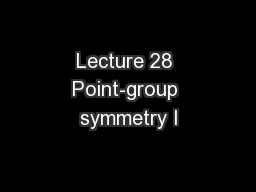

Molecular symmetry A typical conversation between chemists Symmetry is the language all chemists use every day besides English and mathematics Formaldehyde is C 2v The A ID: 758000
Download Presentation The PPT/PDF document "Lecture 28 Point-group symmetry I" is the property of its rightful owner. Permission is granted to download and print the materials on this web site for personal, non-commercial use only, and to display it on your personal computer provided you do not modify the materials and that you retain all copyright notices contained in the materials. By downloading content from our website, you accept the terms of this agreement.
Slide1
Lecture 28
Point-group symmetry ISlide2
Molecular symmetry
A typical conversation between chemists …
Symmetry is the “language” all chemists use every day (besides English and mathematics).
Formaldehyde is C
2v. The A1 to B2 transition is optically allowed.
This vibrational mode is A
g
. It is Raman active.Slide3
Molecular symmetry
We will learn how to
classify a molecule to a symmetry group,characterize molecules’ orbitals, vibrations, etc. according to symmetry species (
irreducible representations or “irreps”),use these to label states, understand selection rules of
spectroscopies and chemical reactions.Slide4
Molecular symmetry
We do not need to
memorize all symmetry groups or symmetry species (but we must know common symmetry groups, C1, Cs, Ci
, C2, C2v, C2h, D2h,
C∞v, D∞h, and all five symmetry operations/elements),memorize all the character tables,memorize the symmetry flowchart or pattern matching table,know the underlying mathematics (but we must have the operational understanding and be able to apply the theory routinely). Slide5
Mathematics behind this
The symmetry
theory we learn here is concerned with the point-group symmetry, symmetry of molecules (finite-sized objects).There are other symmetry theories, space-group symmetry for crystals and line-group symmetry for crystalline polymers.These are all based on a branch of mathematics called group theory
.Slide6
Primary benefit of symmetry to chemistrySlide7
Symmetry
logic
Symmetry works in stages. (1) List all the symmetry elements of a molecule (e.g., water has mirror plane symmetry); (2) Identify the symmetry group of the molecule (water is C2v); (3) Assign the molecule’s orbitals, vibrational modes, etc. to the symmetry species
or irreducible representations (irreps) of the symmetry group.In this lecture, we learn the symmetry elements and symmetry groups.Slide8
Five
symmetry operations
and elementsIdentity (the operation); E (the element)n-fold rotation (the operation); Cn, n-fold
rotation axis (the element)Reflection (the operation); σ, mirror plane (the element)
Inversion (the operation); i, center of inversion (the element)n-fold improper rotation (the operation); Sn, n-fold improper rotation axis (the element)Slide9
Identity,
E
is no operation (doing nothing), which leaves the molecule unchanged.Any and every molecule has this symmetry element.Slide10
n
-fold
rotation, CnRotation through 360º/n around the axis.The axis with the greatest value of n is called the principal axis
.Slide11
Reflection
σ
v parallel (vertical) to the principal axisσh perpendicular (horizontal)σ
d bisects the angle between two C2 axes (diagonal or dihedral)Slide12
Inversion
Inversion maps (
x, y, z) to (–x, –y, –z).Slide13
n
-fold improper rotation
Rotation through 360º/n around the axis followed by a reflection through σh.Slide14
Symmetry classification of molecules
Molecules
are classified into symmetry groups. The classification immediately informs us of the polarity and chirality of the moleculeWe have two naming conventions – Schoenflies and Hermann–Mauguin
system (International system) – we use the former.Slide15
C
1 group
has only identity symmetry element.Slide16
C
i group
has identity and inversion only.Slide17
C
s group
has identity and mirror plane only.Slide18
C
n group
has identity and n-fold rotation only.Slide19
C
nv group
has identity, n-fold rotation, and σv only.Slide20
C
nh
grouphas identity, n-fold rotation, and σh (which
sometimes imply inversion).Slide21
D
n
grouphas identity, n-fold principal axis, and n twofold axes perpendicular to Cn.Slide22
D
nh group
has identity, n-fold principal rotation, and n twofold axes perpendicular to Cn, and σh.Slide23
D
nd
grouphas identity, n-fold principal rotation, and n twofold axes perpendicular to Cn, and σd
.Slide24
S
n
groupmolecules that have not been classified so far and have an Sn axisSlide25
Cubic group
Tetrahedral
group: CH4 (Td), etc.Octahedral group: SF6 (Oh), etc.Icosahedral group: C
60 (Ih), etc.Slide26
Flow chart
YES
NO
YES
NOYESNO
YES
NO
YES
NO
YES
NO
YES
NO
YES
NO
YES
NO
YES
NO
YES
NO
YES
NO
YES
NO
YES
NOSlide27
Flow chart
YES
NO
YES
NOYES
NO
YES
NO
YES
NO
YES
NO
YES
NO
YES
NO
YES
NO
YES
NO
YES
NO
YES
NO
YES
NO
YES
NOSlide28
Pattern matchingSlide29
Pattern matchingSlide30
Polarity
Dipole moment should be along
Cn axis. There should be no operation that turn this dipole upside down for it not to vanish.Only C1, Cn, Cnv, and C
s can have a permanent dipole moment.Slide31
Chirality
A
chiral molecule is the one that cannot be superimposed by its mirror image (optical activity)A molecule that can be superimposed by rotation after reflection (Sn) cannot be chiral.Note that
σ = S1 and i = S2
. Only Cn and Dn are chiral.Slide32
Homework challenge #9
Why does the reversal of left and right occur in a mirror image, whereas the reversal of the top and bottom does not?
Public domain image from WikipediaSlide33
Summary
We have learned five symmetry operations and symmetry elements.
We have learned how to classify a molecule to the symmetry group by listing all its symmetry elements as the first step of symmetry usage.From this step alone, we can tell whether the molecule is polar and/or chiral.